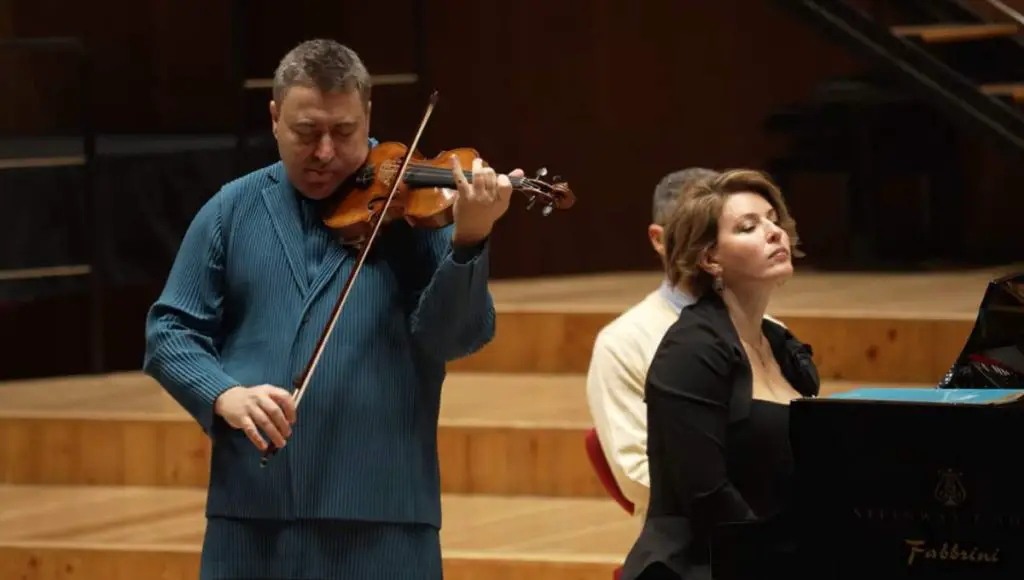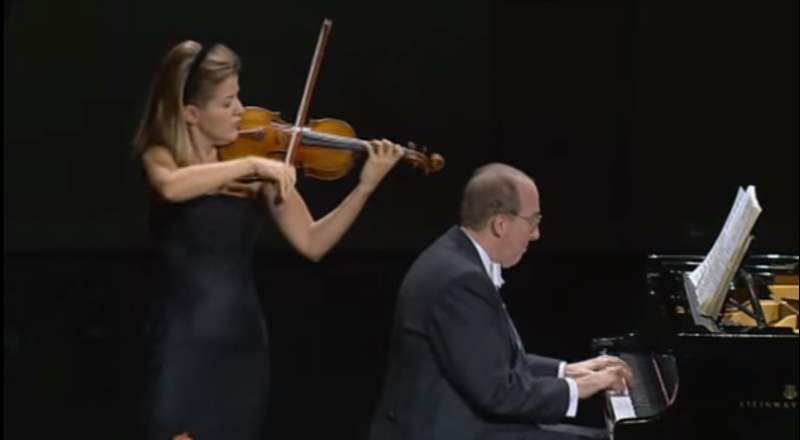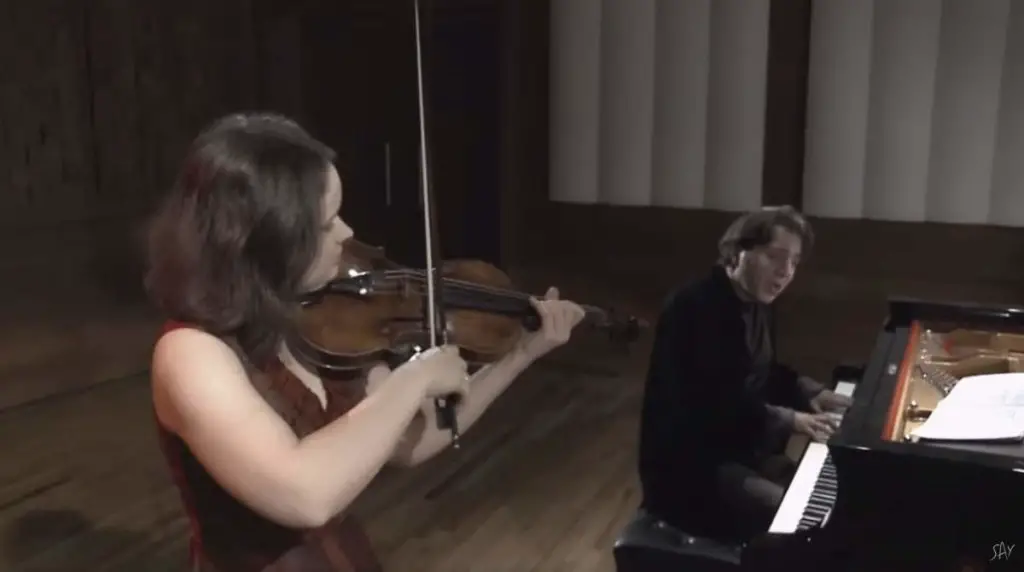Latvian classical violinist Gidon Kremer and the Argentine pianist Martha Argerich perform Ludwig van Beethoven’s Violin Sonata No. 9 Opus 47, commonly known as the “Kreutzer Sonata”. Recorded in 1987.
Ludwig van Beethoven’s Violin Sonata No. 9, the “Kreutzer Sonata”
The “Kreutzer Sonata” was originally dedicated to the Afro-European (born in Poland) violinist George Bridgetower (11 October 1778 – 29 February 1860), who performed it with Beethoven at the premiere on 24 May 1803 at the Augarten Theatre at a concert that started at the unusually early hour of 8:00 am. Bridgetower sight-read the sonata; he had never seen the work before, and there had been no time for any rehearsal.
However, research indicates that after the performance, while the two were drinking, Bridgetower insulted the morals of a woman whom Beethoven cherished. Enraged, Beethoven removed the piece’s dedication, dedicating it to the French violinist Rodolphe Kreutzer (15 November 1766 – 6 January 1831), who was considered the finest violinist of the day. However, Kreutzer never performed it, considering it “outrageously unintelligible”. He did not particularly care for any of Beethoven’s music, and they only ever met once, briefly.
Sources suggest the work was originally titled “Sonata mulattica composta per il mulatto Brischdauer (Bridgetower), gran pazzo e compositore mulattico” (Mulatto Sonata composed for the mulatto Brischdauer, big wild mulatto composer), and in the composer’s 1803 sketchbook, as a “Sonata per il Pianoforte ed uno violino obligato in uno stile molto concertante come d’un concerto”.
Referring to Beethoven’s composition, Leo Tolstoy’s novella The Kreutzer Sonata was first published in 1889. That novella was adapted into various stage and film productions, contributing to Beethoven’s composition becoming known to the general public.
Movements
1. Adagio sostenuto – Presto
The Kreutzer Sonata is a compelling blend of emotional depth and technical brilliance that has captivated audiences and musicians alike since its composition in 1803. It starts with an Adagio sostenuto, a slow and expressive introduction that sets a dramatic tone, creating an atmosphere of anticipation and tension. This mood swiftly gives way to the Presto, the main body of the movement, which is remarkable for its vigorous energy and the technical demands it places on both performers.
This movement is distinguished by its considerable length and complexity, which marked a significant departure from the violin sonatas of Beethoven’s predecessors. It was innovative not only for its structural and technical aspects but also for the way it treated the violin and piano as equal partners in a musical dialogue. This was a novel approach at the time, as the violin often played a dominant role in sonatas, with the piano serving a more accompaniment function. In the “Kreutzer Sonata,” however, Beethoven demands virtuosic performance from both instruments, creating a rich interplay that enhances the music’s emotional impact.
The technical challenges for the performers are manifold, including rapid passages, double stops (playing two notes simultaneously) on the violin, and wide leaps, alongside precise articulation and dynamic contrasts in the piano part. These elements contribute to the movement’s dramatic effect, maintaining a high level of intensity and engagement throughout.
Moreover, the emotional range of this movement is vast, moving from initial tension and anticipation to moments of frenetic energy. This is achieved through Beethoven’s masterful use of dynamics, rhythm, and thematic development, which keeps the listener emotionally invested from beginning to end.
2. Andante con variazioni
The second movement of “Kreutzer Sonata” serves as a captivating interlude between the vigorous outer movements, displaying Beethoven’s exceptional flair for variation. Titled “Andante con Variazioni,” it is a journey through a series of imaginative transformations of a simple yet elegant theme in F major. This movement unveils the composer’s ability to delve deep into the emotional and technical realms of a single musical idea, showcasing a more reflective and lyrical aspect of his musical genius.
Initiating with a theme that exudes serenity, introduced first by the piano and then entwined with the violin, Beethoven sets the stage for an explorative adventure in sound. The theme itself is the canvas, upon which Beethoven paints a series of variations, each altering the melody, harmony, rhythm, or texture, revealing new dimensions and perspectives of the initial musical material. Through these variations, the movement traverses a spectrum of emotions, from contemplative tranquility to spirited playfulness, offering listeners a glimpse into the composer’s rich inner world.
In this movement, Beethoven continues to treat the violin and piano as equal partners, engaging in a nuanced dialogue that underscores the compositional craftsmanship of the era. The variations serve as a platform for both instruments to demonstrate their expressive capabilities, sometimes through soloistic displays, at other times through intricate interplay, thus enriching the sonic palette of the movement.
Beyond the technical demands of articulation, dynamics, and phrasing, the “Andante con Variazioni” requires performers to possess a profound musical sensitivity. Each variation demands not only a meticulous attention to the technical aspects but also a deep understanding of the shifting emotional landscapes, challenging musicians to convey the nuanced changes in mood and character inherent in the music.
Through the second movement of the “Kreutzer Sonata,” Beethoven masterfully illustrates the power of variation as a means to explore and expand upon a musical idea, enriching the listener’s experience. This movement not only acts as a reflective pause in the sonata but also showcases Beethoven’s innovative approach to the violin sonata genre, highlighting the expressive and technical potential of both instruments in a deeply moving and contemplative manner.
3. Presto
The third movement of the Kreutzer Sonata bursts forth with energy and intensity, marking a dramatic departure from the reflective and lyrical nature of the second movement. This final movement, a fiery and spirited Presto, encapsulates the revolutionary spirit of Beethoven’s composition, blending technical mastery with profound emotional expression.
Commencing with an impetuous opening, the movement immediately establishes a tone of urgency and excitement. The rapid tempo and vigorous rhythms create a sense of forward momentum, driving the music with an unstoppable force. This movement is characterized by its brilliant virtuosity, with both the violin and piano engaging in passages of breathtaking speed and complexity. The interplay between the instruments is more dynamic and confrontational than in the previous movements, showcasing their full expressive range.
The Presto is a testament to Beethoven’s ability to convey a wide array of emotions through music. Amidst the technical fireworks, there are moments of poignant lyricism, where the tension momentarily subsides, allowing for brief introspective pauses before the energetic themes resume. These contrasts add depth to the movement, highlighting Beethoven’s mastery of musical storytelling.
The technical demands on the performers are immense, requiring precision, agility, and a deep connection between the violinist and pianist. The rapid-fire exchanges, synchronized runs, and intricate counterpoint test the limits of the musicians’ virtuosity, making the movement a thrilling challenge for performers and an exhilarating experience for listeners.
In this Presto, Beethoven not only concludes the “Kreutzer Sonata” on a note of high drama and intensity but also reaffirms the innovative nature of the work as a whole. The movement serves as a culmination of the sonata’s exploration of the possibilities of musical dialogue between violin and piano, pushing the boundaries of the sonata form and chamber music performance.
The third movement’s blend of virtuosic display and emotional depth encapsulates the essence of Beethoven’s musical genius. It provides a fitting conclusion to a sonata that has challenged and inspired musicians and audiences alike since its inception, affirming the “Kreutzer Sonata” as one of the pinnacles of the violin repertoire. Through this movement, Beethoven demonstrates not only his compositional prowess but also his vision for music as a medium of profound expression and human connection.
Sources
- Violin Sonata No. 9 (Beethoven) on Wikipedia
- Violin Sonata No. 9, Op.47 (Beethoven, Ludwig van) on the International Music Score Library Project website
- Beethoven: Violin Sonata No. 9 in A major, Op. 47 (“Kreutzer”) on the L.A. Phil website


